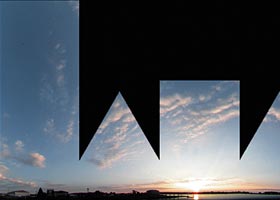For more archives, go to the Advance Archive/Search Page.
Artworks Depicting Light of Coastal Region
Showcased at Avery Point Exhibit
Whether it’s a sunrise turning the sky into a blaze of color or a sunset drenching the sea in orange, David Madacsi will be there with his camera.
“I’m fascinated by light,” says Madacsi, a photographer who for the past 27 years has lived on Mystic harbor. “I’ve been watching the light for many years. I have a view of the sun in the sky from the time it rises until the time it sets.”
 |
“Unfolded Sky, October Sunrise” is one of the images on display in an exhibit exploring the connections between light, art, and place that is now on display at the Alexey von Schlippe Gallery of Art at Avery Point. |
Photo by David Madacsi |
Madacsi, a professor emeritus of physics, has taken his interest a step further: He has curated an exhibit, “Unfolding this Light, A Visual Inquiry into the Interconnections of Light, Art, & Place” at the Alexey von Schlippe Gallery of Art at the Avery Point Campus in Groton. The show combines images from Madacsi’s own photographic study of the light of coastal Connecticut with works by 10 contemporary artists “whose work is especially informed by the light of this region,” he says. The exhibit, which runs from Nov. 12 through Dec. 19, includes about 30 of Madacsi’s photographs taken with a digital camera. The other artists’ works cover a broad range of genres and media.
“There are many places in the world with the reputation that there is something special about the natural light, that have especially attracted artists,” Madacsi says. “During the last century, for instance, many artists worked in the areas stretching from Cos Cob to Old Lyme to Mystic, reputedly at least in part because the light there is extraordinary.
“The works of many artists have been linked to a particular local environment, as has been the case in Europe in places such as Barbizon, Provence, and Venice, as well as here in Provincetown, Taos, the Hudson River Valley, and the Hamptons,” Madacsi adds. “I’m intrigued with the question about the interconnection among light, art, and place and I consider this exhibit itself a visual inquiry.”
For a number of years, Madacsi has tried to understand what it is that makes the light in these places so special. Some time ago, he thought about the surface of the moon. “If we look at pictures of the moon from the Apollo astronauts,” he says, “it was exciting to be there, but not visually stimulating. If you’re standing on the surface of the moon, the sky itself is completely black, even when the sun is high. And that’s because there is no atmosphere.”
Sometime after that, “I was in New Mexico, at White Sands,” he says, “where there are hundreds of square miles of white sand dunes. I was there at sunset when there was a full moon rising. The sky was gorgeous and I took photos of it and the colors reflected in the sand. I later realized that it was the same topography as the surface of the moon. In fact, if we took away the atmosphere, the White Sands picture would look identical to the picture on the moon. So just the presence of the atmosphere does amazing things in terms of the aesthetics of the environment.”
Madacsi’s photograph “Coastal Morning October” depicts a sunrise over water. “I really like this image,” he says. “I had gotten up very early before the sun rose. There was some cloudiness in the sky and I started taking pictures. Then the sun started to come up and burn through the haziness and fairly light cloudiness. It was really difficult to focus directly on the emerging sun and capture the moment before it became too bright. I was afraid I’d ruin the camera.”
“Sky meets Sea (meets Sky),” a photo taken on a cove of the Mystic River around sunrise, shows a pinkish sky reflected in the water. “It was taken with a fisheye lens which has a 183 degree field of view and the image is obviously distorted, but it has taken in everything that was in front of me, from straight up to straight down and left to right,” Madacsi says. “If I point the camera lens up at the sky, I’ll have the entire sky all around the horizon.”
Other works in the exhibit include impressionist landscape oils by Timothy Mockler of Noank and Leif Nilsson of Chester, and pastels by Gigi Horr Liverant of Colchester, encaustics (where pigments are mixed with wax) by Anne Culver of Gilford, and watercolors by Sharon Hunter of New Haven and Pamela Pike Gordinier of Mystic. Non-representational work includes oils and mixed media by Guido Garaycochea of Peru, Chile, and New London, oils by Janet Lage of Old Lyme, oils and mixed media by Julia Pavone of Old Lyme, and monoprints by Alida Ferrari of New London.

